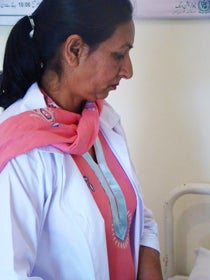 "Several mothers’ life is in danger due to placenta previa at child birth however either the village is too far flung to receive medical assistance or the family refuses to let the mother seek a specialist’s help,” the lady health worker said in response to my query regarding the past month’s performance in-field.
"Several mothers’ life is in danger due to placenta previa at child birth however either the village is too far flung to receive medical assistance or the family refuses to let the mother seek a specialist’s help,” the lady health worker said in response to my query regarding the past month’s performance in-field.
Maternal Health Care remains a low priority concern not only amongst the rural and urban poor households in Punjab, Pakistan, but amidst the policy circles as well. In Pakistan, for every 100,000 babies born, some 260 women die during childbirth. The country is one of 11 countries that comprised 65% of global maternal deaths in 2008. Yet most maternal deaths could be prevented if a skilled practitioner attended the birth.
The solution to this problem is multi-pronged. The issue must be tackled individually at the following thresholds:
a) Quality of the Maternal Health Care Program
b) Receptivity by the public
c) Data, Research and Execution
It is evident the solution requires institutional, cultural and political changes, however is it possible to evade the long term institutional changes and usher in economic and social independence, thereby pardtially addressing the solution in the short run?
Lady Health Workers in Punjab, Pakistan are being equipped with a mobile device that is synchronized with data collection server at the back end. The initiative will serve dual purposes of facilitating quick response to medical crisis in the areas identified and data collection for policy action in the future.
This project bypasses the problem of male hegemony over technology and gives rise to the question of the extent to which technological innovations can empower women in South Asia? Can male participation and support be evaded or it is a necessity beyond which this policy issue has no solution?
Policy analysts have long debated that any solution that does not transform male mindset cannot achieve significant impact. However, equipping women health workers with mobile phone has indeed evaded the issue of enlisting male support. However is it a comprehensive and sustainable solution?
It is by no means comprehensive. However case studies from around the globe prove the fact that various facets of women subjugation have been addressed by diverse and innovative solutions. Reporting Violence in Egypt via crowd mapping has positively impacted the lives of many. Cellphones in Uganda have been used to report violence, however lack of institutional followup either due to conflict prone environment or government apathy renders such initiatives worthless.
In addition according to the Cherie Blair Foundation - Woman are 21% less likely to own a mobile phone than a man = the number increases for Africa (23%) the Middle East (24%), and South Asia (37%) On the other hand, statistics in South Asia show that show that women will walk to call centers or borrow phones. There have been innovations in developing cloud applications, so they can access literacy or health programs via any phone they have access to.
As mobile phone penetration is increasing across the region, so will the impact. There is enormous room to innovate and seek solutions to such policy crisis. The youth must step up, assume charge and seek solutions to longstanding issue of women subjugation in South Asia and around the globe.


Join the Conversation